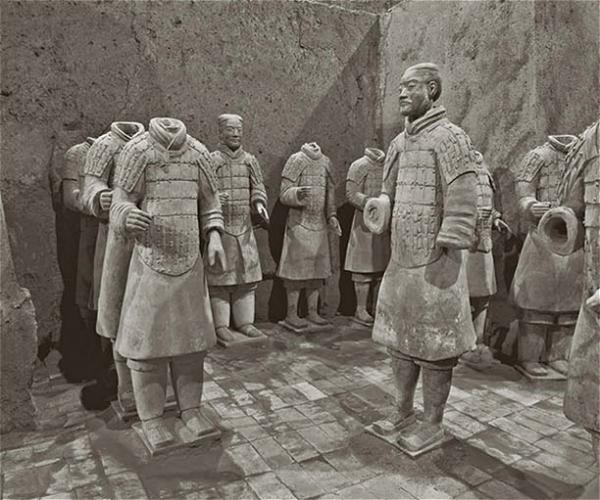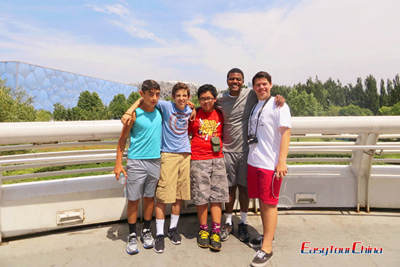15 Must-Know Fascinating Facts about the Terracotta Army in China
1. What Are the Terracotta Warriors
The Terracotta Warriors are a huge collection of ancient burial pits, filled with thousands of clay soldiers and horses. They form a key part of the Emperor Qin Shi Huang’s Mausoleum Museum. One of the key facts about the Terracotta Army in China is that they are burial objects shaped like military figures (chariots, horses, and soldiers), rather than human sacrifice. In 1987, the Mausoleum of the First Qin Emperor and the Terracotta Army pits were inscribed on the UNESCO World Heritage List and hailed as the "Eighth Wonder of the World."

2. Where Are Terracotta Warriors and Where Can You See Them
The Terracotta Warriors are located in Lintong, Xi’an, about 1.5 km from the tomb of China’s first emperor, Qin Shi Huang. Today, if you want to see the Terracotta Warriors during your Xi'an tours, you can go to Emperor Qinshihuang's Mausoleum Site Museum, which consists of the Museum of the Terracotta Warriors and Horses of Qin Shi Huang and the Mausoleum Site Park of the First Qin Emperor (Lishan Garden).
>> Recommended Xi’an Day Tour to Terracotta Warriors
3. Why Was the Terracotta Army Built?
Among all facts about the Terracotta Army, this may be the most important: Emperor Qin Shi Huang constructed them to protect his safety after death. He believed these clay soldiers would guard his tomb from enemies, just as his real army did in life. They also celebrated his victories in uniting China and showed everyone—then and now—just how powerful his empire was.4. How Old Are the Terracotta Warriors
One of the most fascinating facts about the Terracotta Warriors is that they are over 2,270 years old, dating back to 246 BC. After ascending the throne at age 13, Emperor Qin Shi Huang, one of the greatest Chinese emperors, began constructing his mausoleum, with the Terracotta Army being constructed simultaneously as his "underground army."
This massive project lasted 38 years. The mausoleum complex remained unfinished at the time of Emperor Qin's death. The final touches were only applied in 208 BC, after construction had been interrupted by peasant rebellions during the collapse of the Qin dynasty, one of China’s greatest dynasties.
5. The Terracotta Warriors Were Discovered by Accident in 1974
One of the most surprising facts about the Terracotta Army in China is that they were accidentally discovered during a drought in 1974, in Xiyang Village, Lintong County, Xi’an. Villagers in Xiyang were digging a well when they found pieces of pottery soldiers about 5 meters underground. At first, they found hard red earth, then broken pottery arms, heads, and even bronze swords.
After learning this news, local authorities immediately dispatched heritage experts to the site. After months of work, they excavated the first complete terracotta figures in the archaeological discovery in 1974, now known as Pit 1. Subsequently, archaeologists discovered Pit 2 about 20 meters northeast of Pit 1, and Pit 3 about 25 meters southwest of Pit 1.

6. Inside the Terracotta Warriors Museum: Three Main Pits to Explore
Another key fact on the Terracotta Army is that there are four discovered Terracotta Army excavation pits, with Pit 1, Pit 2, and Pit 3 arranged in a triangle shape and being the major pits to explore. Pit 1 is the biggest (14,260 sqm) with rows of foot soldiers and chariots - it was found first. Pit 2 (6,000 sqm) has mixed troops with more complete military branches. The small Pit 3 (520 sqm) was probably the army's headquarters with special ceremonial chariots. Pit 4 is empty, and archaeologists still don't know what it was for.
>> Recommended 3-day Xian highlight tour with the Terracotta Warriors
7. How Many Terracotta Warriors Are There?
The total area of the discovered pits exceeds 20,000 square meters, containing approximately 8,000 life-sized terracotta figures of warriors and horses, along with tens of thousands of weapons. Pit 1 contains about 6,000 terracotta figures of warriors and horses, Pit 2 holds about 1,300 terracotta figures, and Pit 3 has 68. Additionally, there are artifacts such as chariots and weapons.8. The Terracotta Warriors Were Originally Painted in Bright Colors
Little-known Terracotta Warriors fact: They were originally painted in colors, not the current gray appearance. The museum's current displays barely hint at their original splendor - Qin artisans meticulously painted each figure with a rich palette of over 20 colors. Infantrymen sported pink faces and green pants, their black hair contrasting with red shoelaces. Green pigments dominated the excavation findings, yet tragically, the ancient lacquer would detach within 15 seconds of air exposure, leaving only traces of its former brilliance.9. Not Only Warriors and Horses: Other Discoveries from the Terracotta Army
Since the discovery of the Terracotta Warriors, people have focused excessively on the figures themselves. Here comes another fact about the Terracotta Warriors. In addition to the terracotta figures, warhorses and chariots, there is also a complete range of weapons, including dagger-axes (ge), spears (mao), halberds (ji), battle-axes (yue), and ceremonial weapons (shu). These were exquisitely crafted and remain extraordinarily sharp after over 2,000 years. Furthermore, bronze birds, cranes, and ducks have also been discovered in nearby pits.10. Who Made the Terracotta Warriors and How Were They Constructed?
Another fact of the Terracotta Army is that they were ordered to be built by Emperor Qin Shi Huang. During the Qin Dynasty, about 700,000 workers, including palace craftsmen and civilian craftsmen from Xianyang, were summoned to make the Terracotta Warriors. They spent 38 years completing these lifelike statues, which are truly amazing. When visiting the Terracotta Warriors, you may notice names on the statues - these are actually the names of the craftsmen who made them.What are the Terracotta Warriors made of? It remains one of the most impressive Xi’an Terracotta Warriors facts. The truth is, each warrior's attire and expression vary because ancient craftsmen used a combination of sculpting and painting techniques with clay molding and firing. They first created a basic form with clay molds, then covered it with fine clay for detailing and coloring. When it comes to precise kiln-firing, some were fired before assembly, while others were assembled before firing through controlled temperatures.
>> Recommended 4-day Xian tour with the Terracotta Warriors

11.How Tall and How Heavy Are the Terracotta Warriors?
As the world's most ancient and monumental clay army, the Terracotta Warriors show remarkable size variations corresponding to military rank. They come in different sizes. Normal soldiers are 1.75-1.85m tall (some over 1.8m), showing how strong Qin soldiers were. Generals are the tallest, up to 1.96m, with fancy hats and armor. Kneeling archers are shorter (about 1.2m) but look ready to fight. Each warrior weighs 120-200kg - just one leg is 20kg!12. Were All the Terracotta Warriors Standing?
The most common type among the Terracotta Warriors is the standing figures. But one of the amazing facts of China's Terracotta Warriors is that there are also sitting figures, kneeling figures, and squatting figures. Additionally, the "Figure No.28" unearthed from the Acrobatics Pit is particularly special. Unlike standing or sitting figures in the pit, it presents a supine posture and is temporarily referred to as the "Supine Figure".13. Why Did the Terracotta Army Remain Undiscovered for Over 2,000 Years?
While countless tombs fell to robbers across the centuries, Qin's Terracotta Army slumbered undisturbed. One of the remarkable ancient China Terracotta Warriors facts is that the dry northwestern soils preserved wooden structures that elsewhere would have rotted. Builders layered ash and stone as natural anti-theft measures. As dynasties rose and fell, layers of windblown earth silently buried the pits deeper. Most crucially, the warriors' positioning - close enough to guard the emperor's spirit, yet distant enough to avoid the main tomb's notoriety - kept their secret until modern farmers struck clay instead of soil.14. Why Do All Unearthed Terracotta Warriors Have Single Eyelids?
There is no definitive academic conclusion regarding why all unearthed Terracotta Warriors in China have single eyelids. Three possible explanations exist. First, most people at that time had monolids. Second, double eyelids soften expressions, while single lids project the stoic discipline expected of soldiers. Lastly, with thousands of figures to produce, artisans may have adopted single lids as a time-saving standard.15. Why Are There No Weapons in the Terracotta Warriors’ Hands Today?
When traveling to the Terracotta Warriors and Horses Museum on your tour of Xi’an, you’ll find that the Terracotta Warriors are posed as if they are wielding weapons. A fun fact about the Terracotta Warriors is that their hands are empty—not by design, but because centuries buried in wet soil rusted metal blades and rotted wooden shafts to nothing. Floods and earthquakes shifted the rubble, and thieves stole what survived. Nature and humans together disarmed Qin’s eternal soldiers.
>> Recommended 4-day historical and archaeological study exploration in Xi’an

FAQs about Terracotta Warriors in China
1. Can you buy a real Terracotta Warrior?
You can't buy real Terracotta Warriors - they're protected artifacts. But you can get imitation ones from gift shops, like small copies or other souvenirs.2. Were the Terracotta Warriors real people?
One of the interesting facts about the Terracotta Army is that the clay soldiers aren't real human beings. They look so real because the makers were very skilled and copied from actual soldiers they saw.3. Are the Terracotta Warriors solid?
The legs and feet of the Terracotta Warriors are solid, while the top parts (head and body) are hollow.4. How to distinguish different types of warriors?
The general figures are very tall - some almost 2 meters. Compared to them, the soldier figures look cuter with their hair tied up in round buns on top, which makes them instantly recognizable.Visit the Terracotta Army with Easy Tour China
The Terracotta Army is a window into Chinese history, and the above-mentioned Terracotta Warriors facts will help you understand them better. To improve your travel experience, you can tour with Easy Tour China, a trusted China tour expert. Our guided tours take you deep into the world of Emperor Qin Shi Huang and the life-sized clay soldiers. Below are our highlighted China tours with the Terracotta Warriors in Xi’an.
Looking for a customized tour of the Terracotta Warriors? Get in touch with us anytime.


